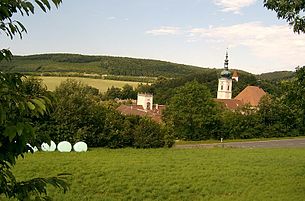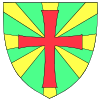Heiligenkreuz (Lower Austria)
|
Heiligenkreuz
|
||
|---|---|---|
| coat of arms | Austria map | |
|
|
||
| Basic data | ||
| Country: | Austria | |
| State : | Lower Austria | |
| Political District : | to bathe | |
| License plate : | BN | |
| Surface: | 29.7 km² | |
| Coordinates : | 48 ° 3 ' N , 16 ° 8' E | |
| Height : | 312 m above sea level A. | |
| Residents : | 1,544 (January 1, 2020) | |
| Population density : | 52 inhabitants per km² | |
| Postcodes : | 2500, 2532, 2534 | |
| Area code : | 02258 | |
| Community code : | 3 06 13 | |
| NUTS region | AT127 | |
| Address of the municipal administration: |
Hauptstrasse 7 2532 Heiligenkreuz |
|
| Website: | ||
| politics | ||
| Mayor : | Franz Winter ( ÖVP ) | |
|
Municipal Council : ( 2020 ) (19 members) |
||
| Location of Heiligenkreuz in the Baden district | ||
 View of Heiligenkreuz with the pen and the A21 in the background |
||
| Source: Municipal data from Statistics Austria | ||
Heiligenkreuz is a municipality with 1544 inhabitants (as of January 1, 2020) in the Vienna Woods in the Baden district of Vienna. The postal name of the main town is Heiligenkreuz in the Vienna Woods (until April 2003: Heiligenkreuz near Baden ).
Well-known Roman Catholic institutions in the area are the Cistercian Abbey Heiligenkreuz (with the Philosophical-Theological College Benedict XVI. - Heiligenkreuz ) and the seminary Leopoldinum (until 2007 Rudolphinum ).
geography
Heiligenkreuz is located in the mountains of the Vienna Woods in the valley of the Sattelbach, a tributary of the Schwechat . The area is part of the industrial district . The old pilgrimage route to Mariazell , the so-called Via Sacra , leads through the village .
Community structure
The municipality includes the following five localities (population in brackets as of January 1, 2020):
- Füllenberg (37)
- Heiligenkreuz (517)
- Preinsfeld (117)
- Sattelbach (157)
- Siegenfeld (716)
The community consists of the cadastral communities Heiligenkreuz and Siegenfeld .
Neighboring communities
| Vienna Woods | Gaaden | |
| Alland |

|
Pfaffstätten |
| to bathe |
history
The time before 1133 is closely related to the history of Alland ; the population will have been extremely small. To the east of today's town in the direction of Siegenfeld, settlement remains of the former town from the 12th century with the name Muchersdorf were found in 1991. This place is mentioned in a letter from 1136, in which the donation of Leopold III, the saint to the Cistercians is documented. The White Cross , today in the middle of the forest, represented the border between Heiligenkreuz and Muchersdorf.
After the establishment of the monastery, the settlement in the surrounding area slowly grew, most of them were employed in the monastic community. In the middle of the 19th century the population had reached 900. In 1850 Heiligenkreuz became an independent municipality with the cadastral communities Heiligenkreuz and Siegenfeld according to the Austrian municipal law of 1849. Abbot Edmund Komáromy - head of the monastery - was elected the first mayor of Heiligenkreuz. The new community of Heiligenkreuz was attached to the Baden administrative district.
population
Population development
Since 1869 (900 inhabitants) the population has increased largely continuously; notable declines were only recorded between 1910 and 1923 and between 1951 and 1961. Between the 1981 and 1991 censuses there was an increase of 19.8%, while in the following ten years (until 2001) the population only increased by 7 people.
| census | Residents |
|---|---|
| 2011 | 1520 |
| 2001 | 1331 |
| 1991 | 1324 |
| 1981 | 1105 |
| 1971 | 1056 |
| 1961 | 946 |
| 1951 | 1083 |
| 1939 | 987 |
Source: Population development of Heiligenkreuz (Lower Austria). (PDF) Statistics Austria
Religions
The vast majority of the population (76.4%) is Roman Catholic . The second largest religious community is Islam (4.7%), closely followed by the Evangelical Church (4.1%). 2.2% profess to the Orthodox Church . 9.6% of the population are without religious beliefs.
politics
The mayor of the community is Franz Winter, the head of the district is Christof Schöny.
The municipal council consists of 19 mandataries. Since the municipal council election on January 25, 2015 , the ÖVP has had 14 and the SPÖ 3 seats and the Greens 2 seats.
Attractions
traffic
The place has public bus connections to Baden near Vienna and Mödling . The Mödlinger road B 11 leads through the town.
It also has a motorway junction from the Vienna outer ring motorway A21.
economy

Due to the pen, tourism is an important economic factor . The monastery itself also has a large forest enterprise with an attached sawmill . In 1981, the monastery implemented the first district heating system with a biomass heating plant in Austria, which initially only supplied the monastery buildings, then community facilities and later also private households.
A trade fair for wood harvesting machines , Austrofoma , which is one of the largest of its kind in Europe, is initiated by the monastery’s forestry operations . The machines are not exhibited here in exhibition halls, but in real forest operations.

There is also a gypsum mine in Preinsfeld , the dismantling stopped in 2001.
Many people from Heiligenkreuz commute to the Baden area to work.

Personalities
- Ottokar Janetschek (1884–1963), railway inspector and writer
- Gottfried Eder (1937–2014), Cistercian in Heiligenkreuz
- Thomas Kakuska (1940-2005), violist
- List of abbots of Heiligenkreuz Abbey
Individual evidence
- ↑ Statistics Austria: Population on January 1st, 2020 by locality (area status on January 1st, 2020) , ( CSV )
- ^ Election results for the 2015 municipal council elections in Heiligenkreuz. Office of the Lower Austrian State Government, December 1, 2015, accessed on July 15, 2019 .
Web links
- 30613 - Heiligenkreuz (Lower Austria). Community data, Statistics Austria .








